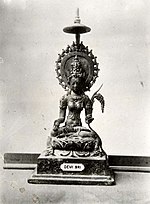| This article is a part of the series on |
| Indonesian mythology and folklore |
|---|
 |
|
|
This article needs additional citations for verification. (March 2012) |
Wawacan Sulanjana is a Sundanese manuscript containing Sundanese myths. The title means "The Tale of Sulanjana", derived from the name of the hero Sulanjana as the protector of rice plant against the attack of Sapi Gumarang cow, Kalabuat and Budug Basu boars symbolizing rice pestilence. The Wawacan Sulanjana contains Sundanese local wisdom through reverence of rice cultivation in its tradition.[1]
The text in Wawacan Sulanjana tells the myth of the Sundanese gods, especially that of the rice goddess Nyi Pohaci Sanghyang Asri (Sri Lakshmi). It also describes the wealth of the ancient kingdom of Pajajaran or Sunda Kingdom with its legendary king Siliwangi. Additionally, it describes the agricultural nature of Sundanese people. The origin of Wawacan Sulanjana probably began as an oral tradition of Pantun Sunda transmitted orally by village story teller across generations. The present copy of Wawacan Sulanjana was estimated to be compiled and composed in a later period, around the 17th to 19th centuries, after the adoption of Islam among the Sundanese. It contains several traces of Islamic mythology such as the Sundanese gods being connected to biblical figures like Adam and the demon Idajil being connected to the Devil (Satan) in Biblical tradition. The present myth contain influences of Hindu and Islamic mythology. However, most of the mythology derives from far older pre-Hindu and pre-Islamic aspect of ancient Sundanese culture. Some trace of Javanese culture is also present, such as the reference to the deity Batara Ismaya disguised as the old servant Ki Semar, and the mentioning of Nawang Wulan apsara that magically cooks rice. In 1907, Plyte translated and compiled the "Wawacan Sulanjana".
- ^ Kalsum (May 2010). "Kearifan Lokal dalam Wawacan Sulanjana: Tradisi Menghormati Padi pada Masyarakat Sunda di Jawa Barat, Indonesia" (PDF). Sosio Humanika. Retrieved 6 April 2012.
